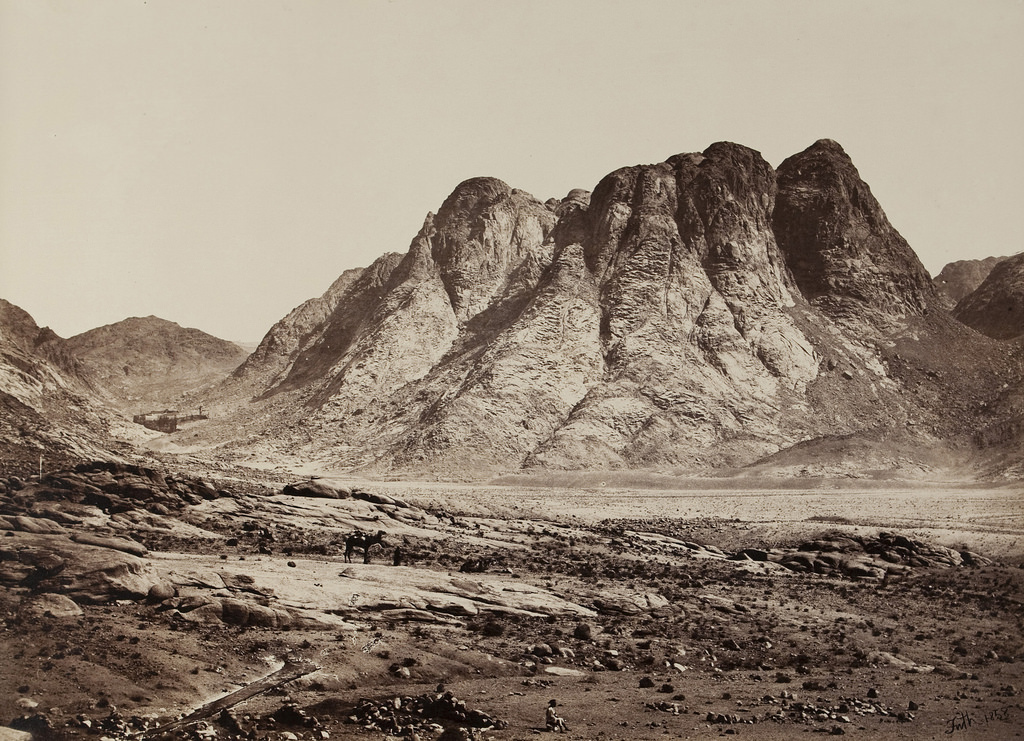The Traditional Site: Jebel Musa/St. Catherine’s in Egypt’s Sinai Peninsula

The case for Jebel Musa and St. Catherine’s Monastery as Biblical Mount Sinai largely rests on the age of the tradition identifying it as such.
Eastern Roman Emperor Justinian founded St. Catherine’s Monastery to honor the mountain as the “Mountain of Moses” (Jebel Musa) in 527 AD. Since that time, Jebel Musa has held most people's belief that it is Mount Sinai.
Dr. Graham Davies of Cambridge University believes that the early Jewish pilgrimages identified Jebel Musa as Mount Sinai and that later Christian pilgrims adopted this tradition.[1] Old Testament scholar R.K. Harrison stated in the Bible Encyclopedia that “Jebel Musa . . . seems to have enjoyed special sanctity long before Christian times, culminating in its identification with Mt. Sinai."
On the subject of Jewish pilgrimages, Dr. Allen Kerkelsager published a scholarly study that went into great detail about these travels, and found that some ancient Jews frequently made pilgrimages to sites associated with their history, such as the Exodus, but that many could not because of the prohibitive cost.
Instead of making the long journey to Jerusalem, sometimes from other parts of the world after the Diaspora, some Jews would travel to sites that were a part of their history. But for many Jews, even this alternative pilgrimage was not affordable. In light of this, Dr. Kerkeslager explains how it becomes plausible that St. Catherine's mountain came to hold the title of Mount Sinai.
Instead they developed alternatives by which Passover and other festivals associated with the Exodus could be celebrated within their own homes and synagogues. Jewish identity therefore became almost completely detached from concrete sites associated with the mythology of the Exodus. This made it easy for Byzantine Christians to attach traditions about the Exodus to new sites that had never been associated with the Exodus in Jewish tradition.
Allen Kerkeslager, “Jewish Pilgrimage and Jewish Identity in Hellenistic and Early Roman Egypt,” in Pilgrimage and Holy Space in Late Antique Egypt, ed. David Frankfurter (Leiden: Koninklijke Brill, 1998), 147.
By the time of Hellenization, it appears that the Jewish people had little interest in the true route to Mount Sinai, so this may have enabled an alternative theory to rise up largely unopposed.
We asked Dr. Thomas Williams, professor of theology at Regina Apostolorum Pontifical Athenaeum in Rome, and he wrote back with his assessment of why Mount Sinai would be located in the southern part of Egypt's Sinai Peninsula.
Several factors suggest the Israelites fled southward into Sinai and that Mount Sinai should be located in the southern sector of the peninsula. First, Exodus 13:17 warned against travel by the “way of the land of the Philistines.” This route, which hugged the northern coast, was the major military route used by the pharaohs and was heavily garrisoned. As part of the great trunk route—the International Coastal Highway—this road would be watched closely by the Egyptians. Second, Deuteronomy 1:2 locates Mount Sinai as an eleven-day journey from Kadesh-barnea, a note that fits best with a Mount Sinai located somewhere in the southern peninsula. Third, the Israelites lost the exact location of Mount Sinai after 850 b.c. when Elijah fled to the holy mountain.
Had the holy mountain been located in the more frequented regions of the north, surely its location would be remembered. Finally, a few sites mentioned on the journey from Mount Sinai to Kadesh-barnea suggest a southern route if the several tentative identifications are plausible. For example, Dizahab (Deut. 1:1) arguably is modern Dahab located on the southeastern coast of the Sinai. Jotbathah (Num. 33:33) may be identified with the Oasis of Taba a few miles south of Ezion-geber (Tell el-Kheleifeh). The following discussion presumes a location for Mount Sinai somewhere in the southern part of the peninsula.
Some supporters of this traditional candidate have pointed to an area where the Golden Calf was allegedly placed.
According to British Egyptologist David M. Rohl, the chapel of Harun (the Biblical name of Aaron) is located at the head of the valley where the Monastery is located and is right at the start of the route up the slopes of Jebel Musa.[2]
Also nearby, to the northwest, is a small shrine upon a hill which proponents believe is the spot upon which Moses stood as the Israelites battled the Amalekites on their way to Mount Sinai.
Josephus
Supporters of this traditional designation argue that it is compatible with the information provided by the famous 1st-century Jewish historian, Josephus. One particular piece of information, which would be required by the criteria, does play in Jebel Musa's favor as Mount Sinai.
The historian Josephus wrote that Mount Sinai was the highest mountain in the region and that its slopes were particularly difficult to ascend. The cluster of mountains by St. Catherine’s Monastery, which includes Jebel Musa and Mt. Catherine, is easily the highest range of mountains in the Sinai Peninsula. It also has what Justinian believed to be the descendant of the Burning Bush, around which the monastery was built.
Criticisms
Jebel Musa/St. Catherine's appears to hold the weight it does because of the length of the tradition more than the actual evidence in its favor. St. Catherine's mountain allegedly has the burning bush in the monastery, but there are few other pieces of real evidence in its favor.
One major criticism is that the mountain is situated in a tightly packed area with little room for a large crowd. If there were upwards of 2 million or more Israelites participating in the Exodus, it's hard to imagine how that many people and their flocks could have fit in this area.
Another problem for the traditional location is the lack of a cave where the prophet Elijah would have stayed when he fled Israel. In 1 Kings 19, Elijah fled the prophets of Baal to Horeb and stayed in the cave at the mountain where he spoke with God. St. Catherine's mountain has no such cave.
The traditional location is problematic based on the routes considered for the Exodus as well. When the Israelites were being led out of Egypt, God chose not to lead them along the Way of the Philistines because the people may have feared war and turned back (Exodus 13).
Rabbi Alexander Hool, author of Searching for Sinai: The Location of Revelation, says in chapter 5 that the fact this route was even considered is evidence that the Israelites were not heading into the Sinai Peninsula, but were rather bypassing this vast and desolate wilderness, with the intention of reaching a location on the opposite shore of the Gulf of Aqaba.
Supporters
Egyptologist Dr. David Rohl
Dr. Graham Davies, Cambridge University
Dr. Thomas Williams, professor of theology at Regina Apostolorum Pontifical Athenaeum in Rome
Dr. James Hoffmeier, Trinity Evangelical Divinity School
Dr. Richard Averbeck, Trinity Evangelical Divinity School
Dr. Kenneth Way, Talbot School of Theology at Biola University
Bibliography:
[1] Graham I. Davies, Society for Old Testament Study Monographs, vol. 5, The Way of the Wilderness: a Geographical Study of the Wilderness Itineraries in the Old Testament (Cambridge: Cambridge University Press, 1979), 23-24.
[2] David M. Rohl, Exodus: Myth or History? (St. Louis Park, MN: Thinking Man Media, 2015), 229.
Last updated April 16, 2019.
